We interrupt this series on Spinning Color exercises to bring you this special message:
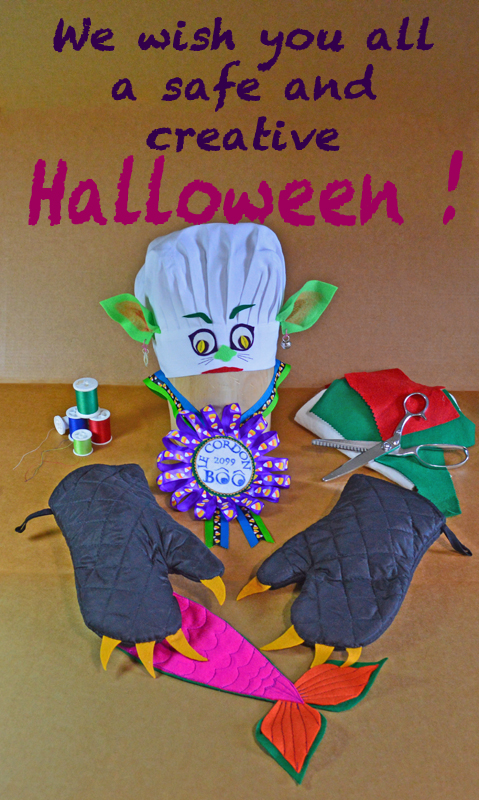 We’re all ready to cook up some “Ghost Boo-ya-base” for Halloween!
We’re all ready to cook up some “Ghost Boo-ya-base” for Halloween!
Thank you! We now return to the originally scheduled postings . . .
We interrupt this series on Spinning Color exercises to bring you this special message:
 We’re all ready to cook up some “Ghost Boo-ya-base” for Halloween!
We’re all ready to cook up some “Ghost Boo-ya-base” for Halloween!
Thank you! We now return to the originally scheduled postings . . .
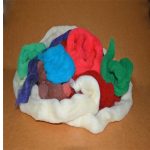 It is possible to get too caught up in the final goal – enjoy the journey and make something for the sake of making it!
It is possible to get too caught up in the final goal – enjoy the journey and make something for the sake of making it!
From this stash of fiber . . .
Introducing . . . Wool Kitty!
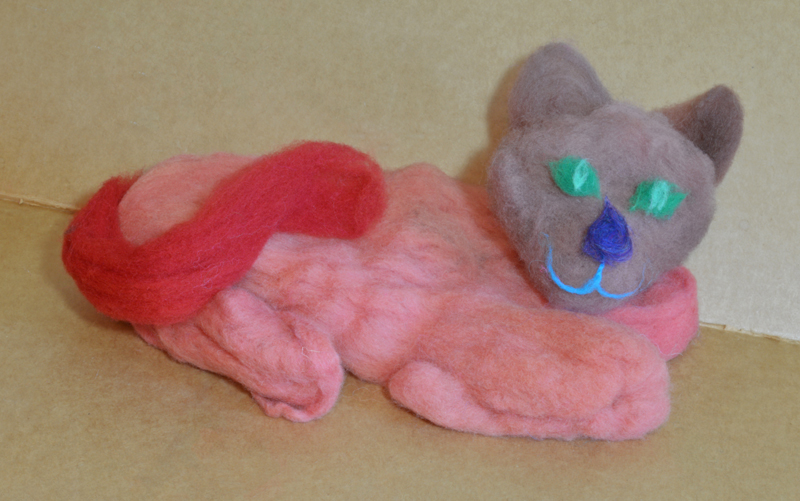 Wool Kitty is ready for a nap on the Dressmakers cardboard!
Wool Kitty is ready for a nap on the Dressmakers cardboard!
Admittedly, not an overly daring color combination, but this collection of colors probably wouldn’t have happened without this stage of making the fiber into an image before carding.
The figure is held together with hairpins so it is easily taken apart. Since it was created only for the photograph we didn’t get overly attached! Spontaneous creativity is like a vacation from deadlines (even self-imposed ones).
The fibers that went into the making of “Wool Kitty”:
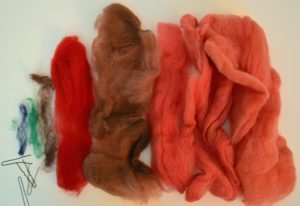
Since the fibers were compacted from long storage, a little carding set everything up for choosing the arrangement for the final yarn. What order would you imagine using?
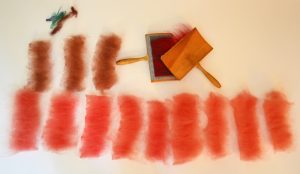
The recipe:
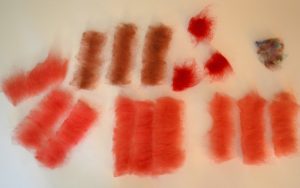
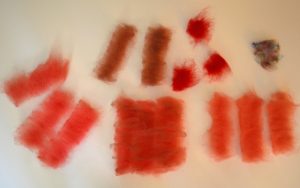
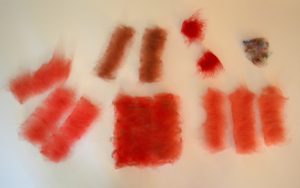
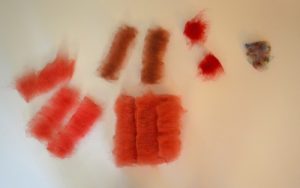
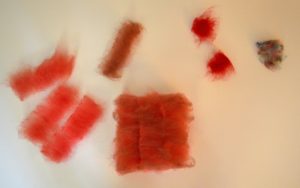
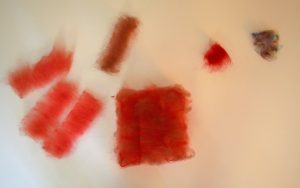
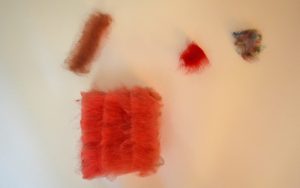
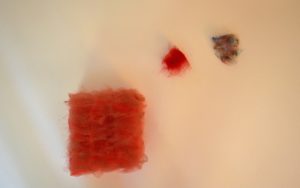
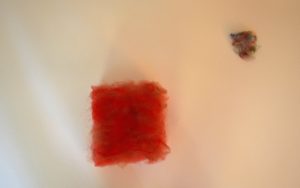

Side view of fiber stack: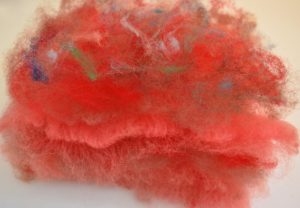
Dividing the stack to elongate it: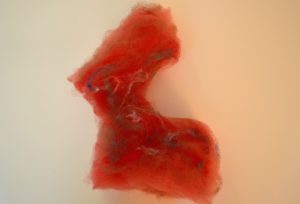
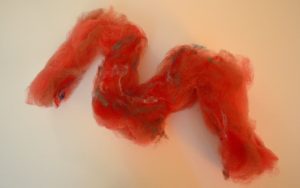
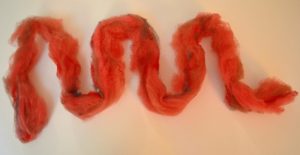
Then we changed our minds and wanted the colors more blended. Allowing yourself the opportunity to change your mind can be a rewarding part of this exercise!
More carding!
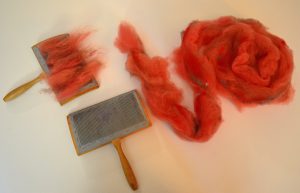
Carded rolags ready for spinning!

Or, another way to look at it:
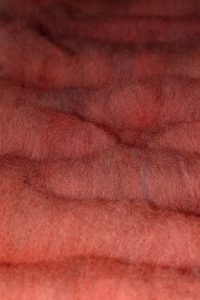
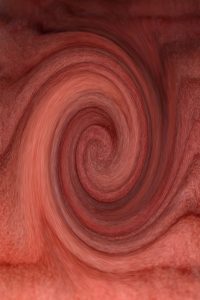
Carded rolags waiting to spin!
As the spinning progressed, the yarn took on a new look and personality. “Wool Kitty” transformed into “Firescale”! Playing with new titles is also a creative activity.
 Working title: “Firescale”, single ply yarn spun on a low whorl drop spindle
Working title: “Firescale”, single ply yarn spun on a low whorl drop spindle
Finished skein, the colors zones are more muted as they are recombined in plying.


This is a cornucopia of leftover wool roving from various hand-dying and spinning projects we have worked on over the years. Each piece in this particular stash has been waiting until there was MORE of something or other in order to be finished into a project. Waiting isn’t as fun as creating. So, what if . . . ?
What if we create a series of color mixing experiments with what there is now? With the notion of using this blog post series to play around, we added a step in between selecting and then blending the roving for spinning to cause us to need to use (and choose) colors in a new way before blending. That step was to make a 3-D fiber illustration first. We have created a multi-part series based on the steps of spinning these images into yarn.
Our hope is that it will amuse non-spinners, intrigue people contemplating starting wool spinning, and encourage adept spinners to try more ways to enjoy the process.
Before reading the next few blog posts imagine how you would mix these colors (feel free to imagine them mingling with your own stash!)
Since we’re reviewing art school fundamentals, another classic one is that artwork’s presentation can really change based on the background color. While we can’t change this particular post to a black background without changing the entire website, these photographs with a black frame will give a bit of an idea for comparison.
We have mixed reviews on which photographs benefit from this black frame. The harsh dark frame looks contrary to the soft texture of the fiber in both the photographs of the snail shell and violet. For the value scale example in the middle, since the black frame picks up the black band in the clam shell and black fiber on the left side of the photograph it works to enclose the right side, which would otherwise seem to spiral out of the composition. The final example provides this post’s punchline!
That is how it is in the studio, sometimes you have to try out several ideas to find what really works best. If we were actually finishing these photographs, none of them would end up with this very narrow black strip, but it is a starting off point for more ideas.
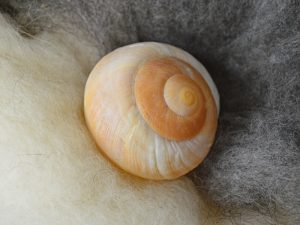

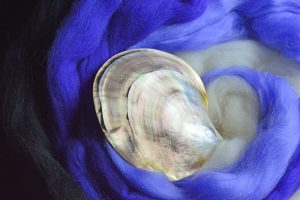
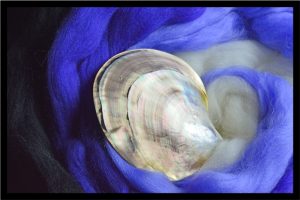
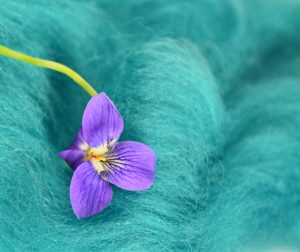

And while a simple coordinating matte can really finish a photograph, if the frame and the contents don’t enhance each other . . . well, see for yourself . . .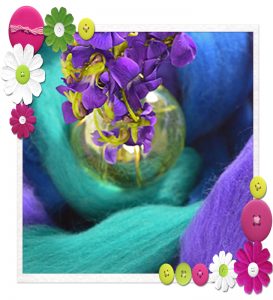 Shall we call this “discomfort zone”?!!!
Shall we call this “discomfort zone”?!!!

Perhaps you have heard the scolding “just break out of your comfort zone” as a way to battle creative stagnation. Try this instead – broaden your comfort zone. Comfort zones themselves can stagnate and need to evolve to catch up with the artist. Finding your own approach to this process is of course what will put some zing back into your zone. We have several ways that are such old school classics that sometimes we need to refresh our working design habits so the ideas flow in the future. The photography exercises that we create for ourselves are part of that process.
In the hottest part of the summer we tend to direct our energy for wool in imagining projects to make in cooler weather. These daydream projects aren’t meant to go into production in a realistic timeline (or budget), however, the surge of ideas generated in designing those wool projects revitalizes our creativity. Not all art projects have to bear a deadline or production goal. It has been very freeing to set up and photograph these temporary fiber compositions since usually our textile work involves very time consuming techniques. Very quickly these color studies became a playground for mixing textures.
Actually, we have comfort zones, plural. We invent so many challenges for ourselves there has to be a few oasis type places in our studio work. We usually find even our wildest ideas rely on some structure found in our comfort zone of design training.
These examples are art school fundamentals that are reliable and a good way to spring off into more daring approaches in both a particular piece of art or a series.
Neutrals: since we’re working with fiber, for sheep “neutral” means Natural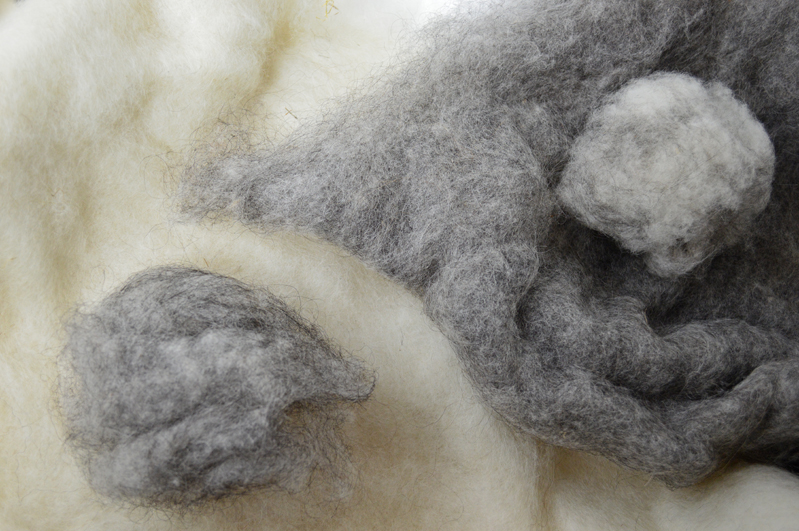
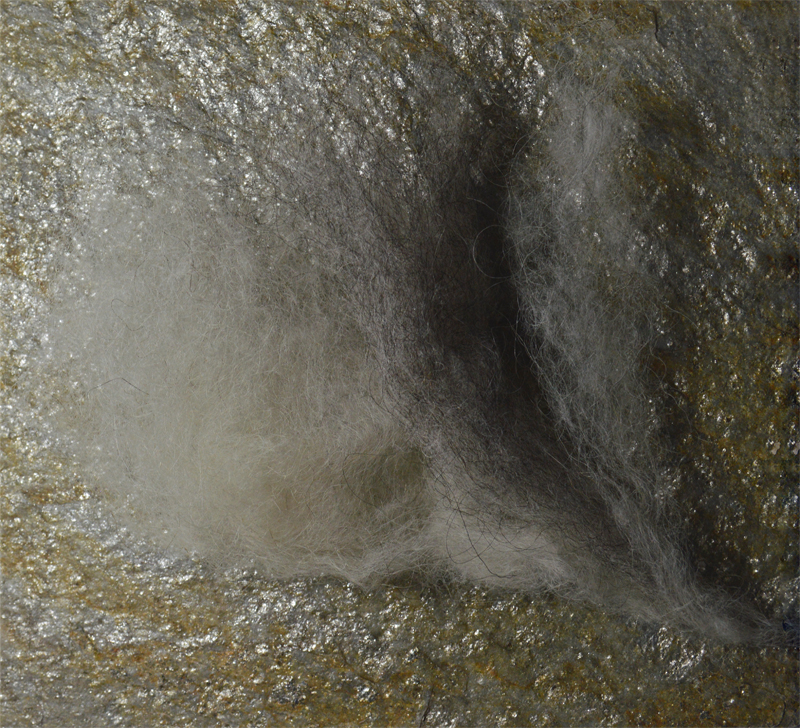
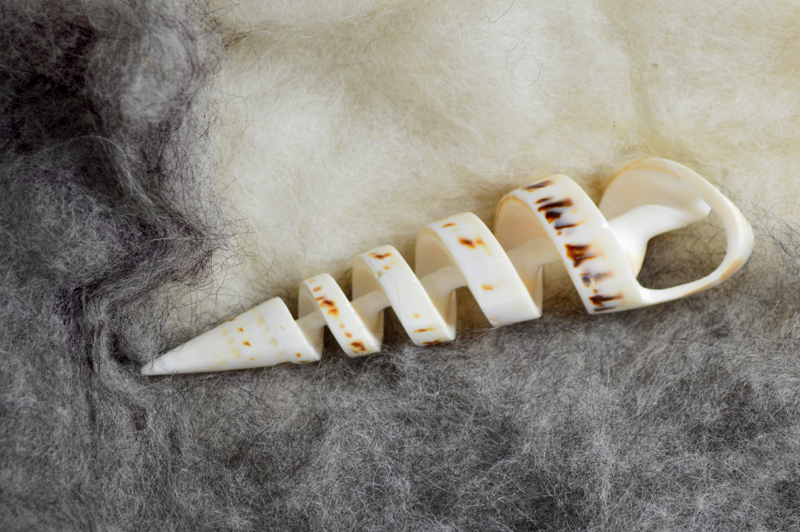
Value scale: white, light, medium, dark and black make an interesting range. A monochromatic scheme can be mild or wild.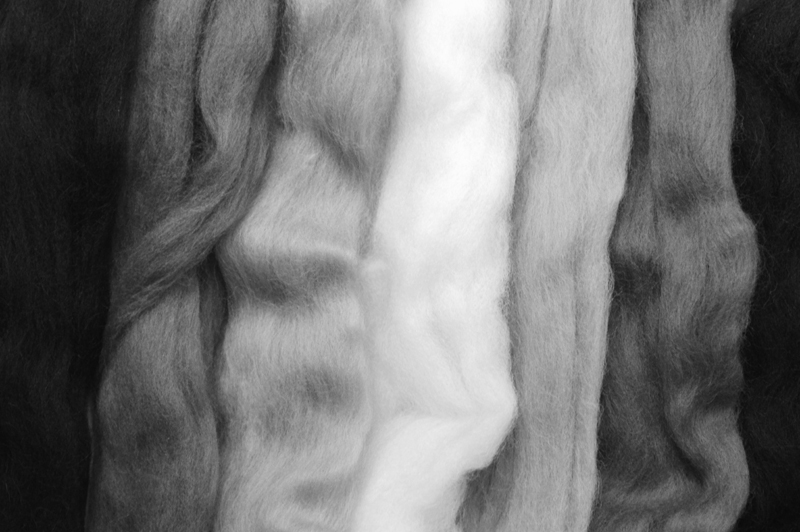
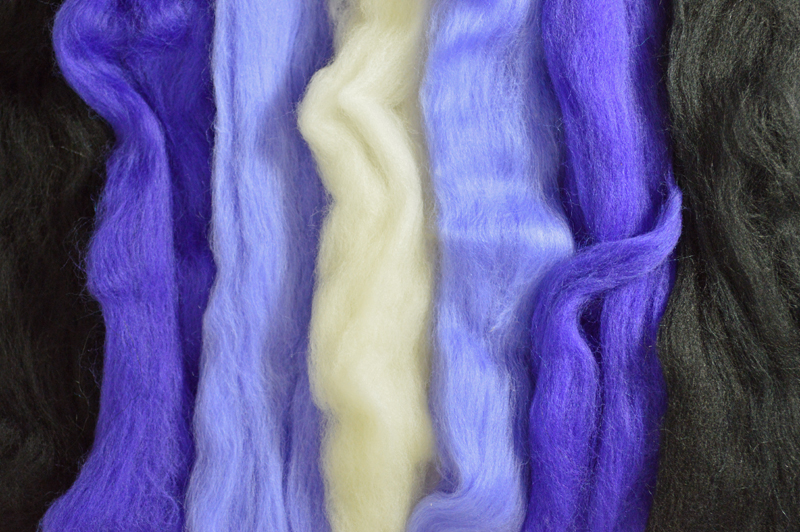
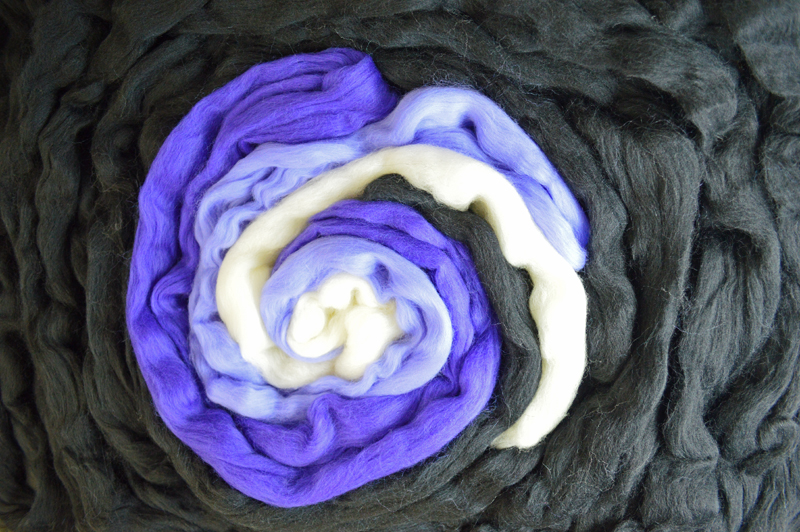

Analogous colors: any three colors side by side by side on the color wheel can touch one’s moods too. There is a soothing rightness about the trio.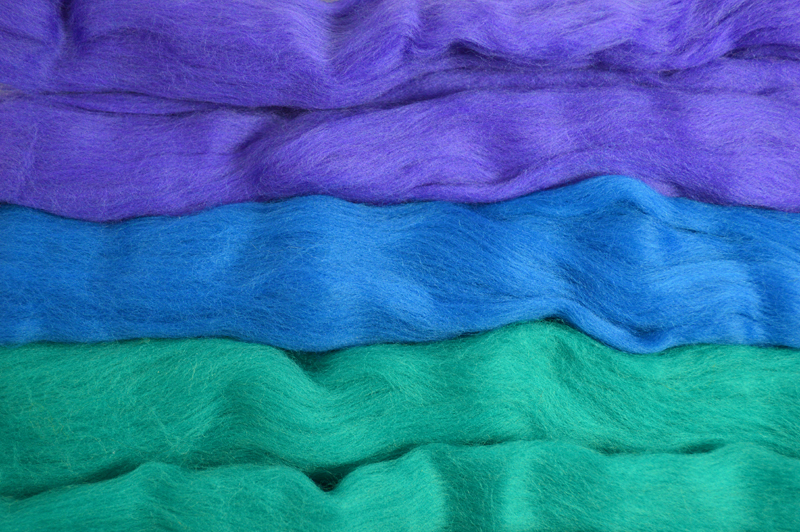
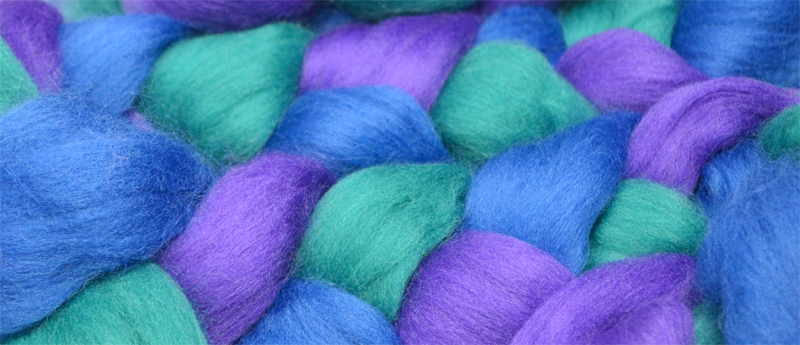
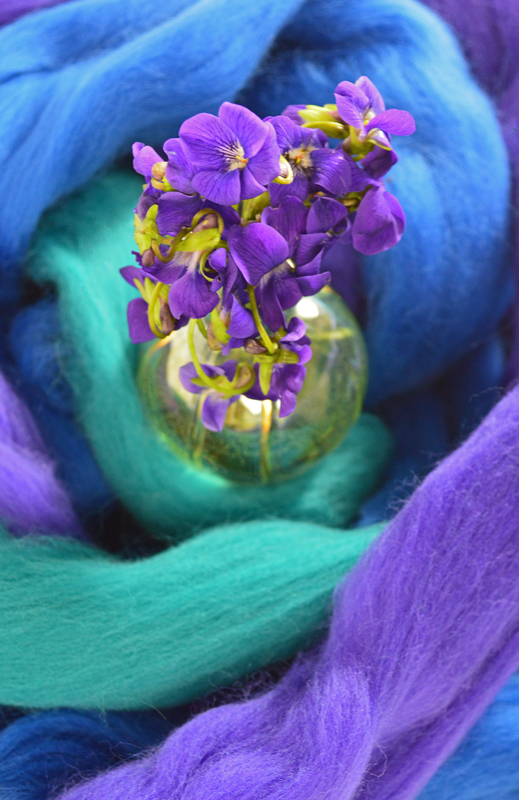
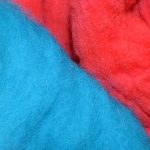 Of course, other people may dive right into high contrast and/or complementary colors to find their comfort zone. The point is that being aware of comfort zones can help an artist create them as needed and even notice those zones change as the artwork progresses. Comfort zones definitely belong in studios!
Of course, other people may dive right into high contrast and/or complementary colors to find their comfort zone. The point is that being aware of comfort zones can help an artist create them as needed and even notice those zones change as the artwork progresses. Comfort zones definitely belong in studios!
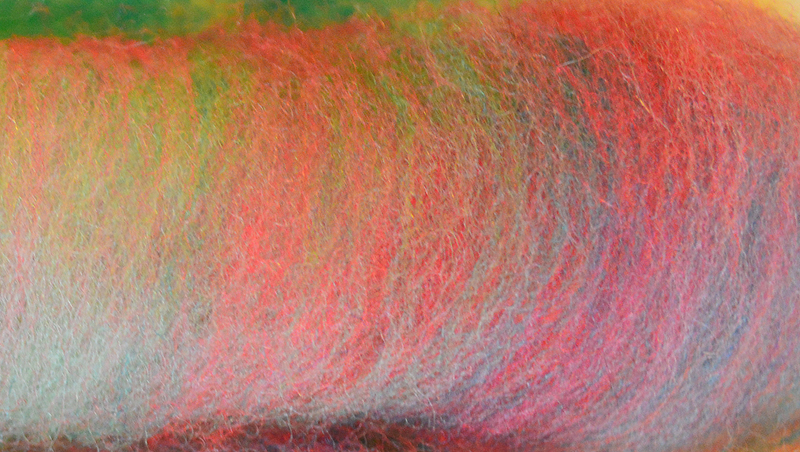 Close-up of a wool “rolag”* waiting to be spun
Close-up of a wool “rolag”* waiting to be spun
Every summertime we know it is coming – the season of harvest and pruning and . . . Local Fiber Festivals!
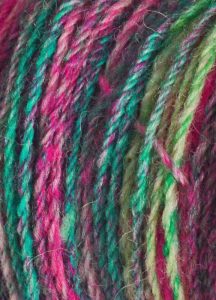 We are big fans of attending OFFF, our local fiber festival. Of course, the many vendors get our attention. It is also filled with demonstrations, barns full of animals and if the weather is cool enough – attendees dressed in sweaters and scarves- it is like a fashion show!
We are big fans of attending OFFF, our local fiber festival. Of course, the many vendors get our attention. It is also filled with demonstrations, barns full of animals and if the weather is cool enough – attendees dressed in sweaters and scarves- it is like a fashion show!
Here is the contact information:
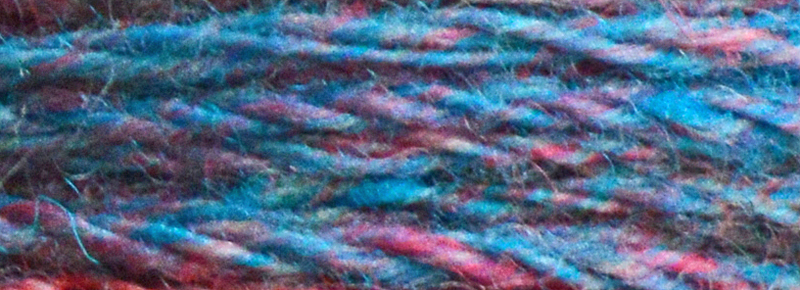 By now, it is starting to show that we put a lot of thought into our art supplies. This is especially true concerning annual sales events. The months leading up to OFFF are when we take stock of our supplies, really enjoy planning future projects and measure what is needed to finish works-in-progress that outgrew estimated boundaries (restraint can be a tough concept!)
By now, it is starting to show that we put a lot of thought into our art supplies. This is especially true concerning annual sales events. The months leading up to OFFF are when we take stock of our supplies, really enjoy planning future projects and measure what is needed to finish works-in-progress that outgrew estimated boundaries (restraint can be a tough concept!)

Years of impulse buys have added up to enough brown fiber to spend the whole winter spinning it, perhaps into spring as well! But, that’s the luxurious project with daydream designs and plans that grow and change each year. While this may not be the year I actually spin the yarn, it may be the year I resist the temptation to buy more brown fiber. Well, let’s not be too hasty with that declaration!
What is exciting are the “what if” plans we have of all the other colors of the spectrum.
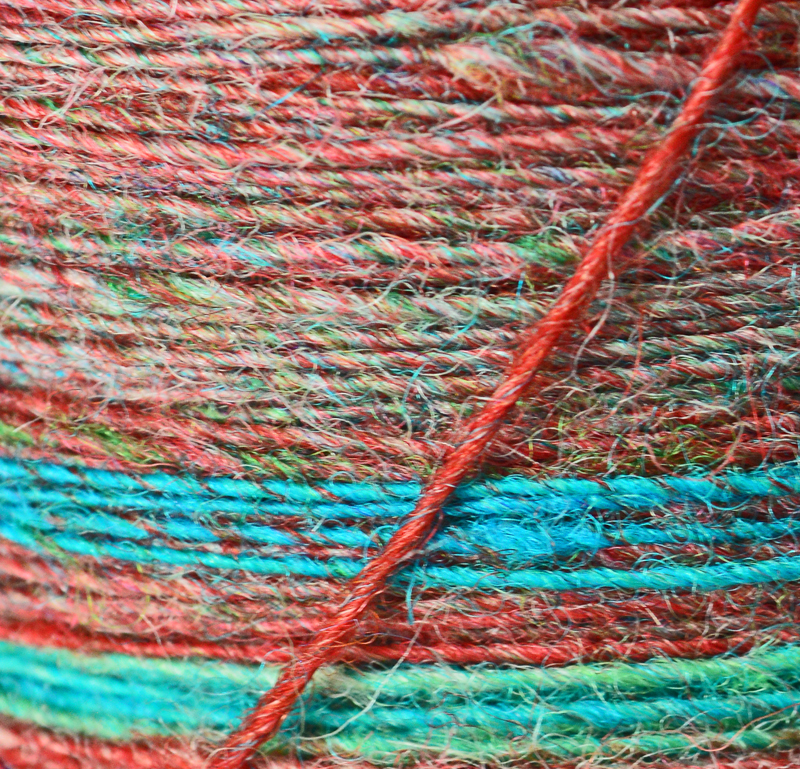
This is the start of a blog post series inspired by the photography exercises we created from the process of making color study exercises as we took inventory. Why? Well, we heard that exercise is good for you!
.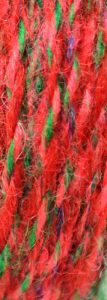
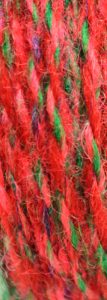
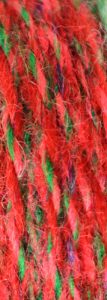
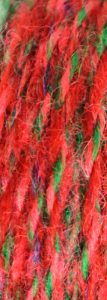
Photographs
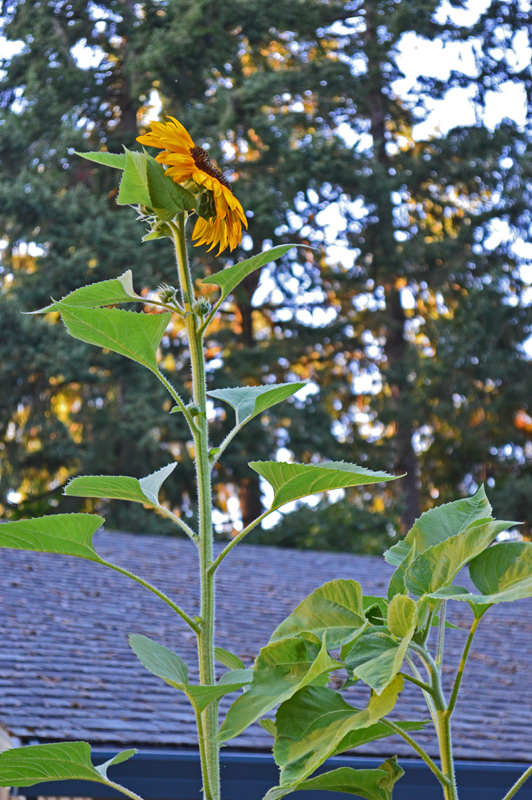
When our uphill neighbor grew these amazing towering sunflowers, how did we manage to get photographs like this with a macro lens?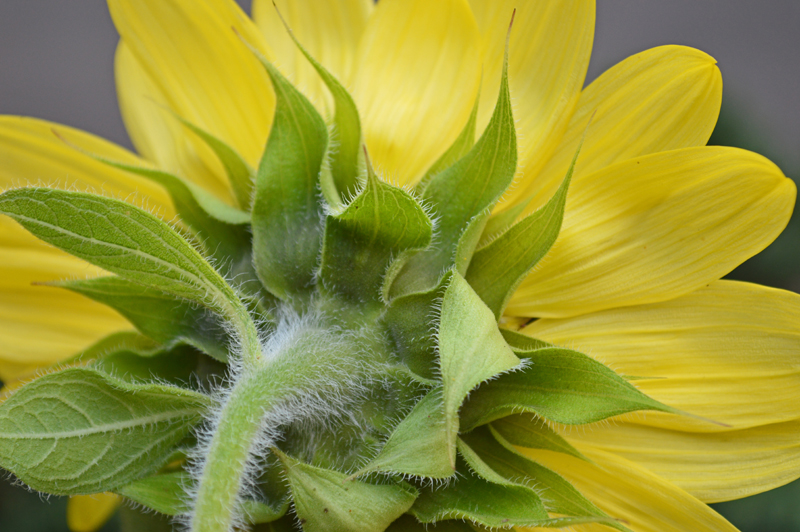
The answer is sometimes you have to put the Photographer on a tripod!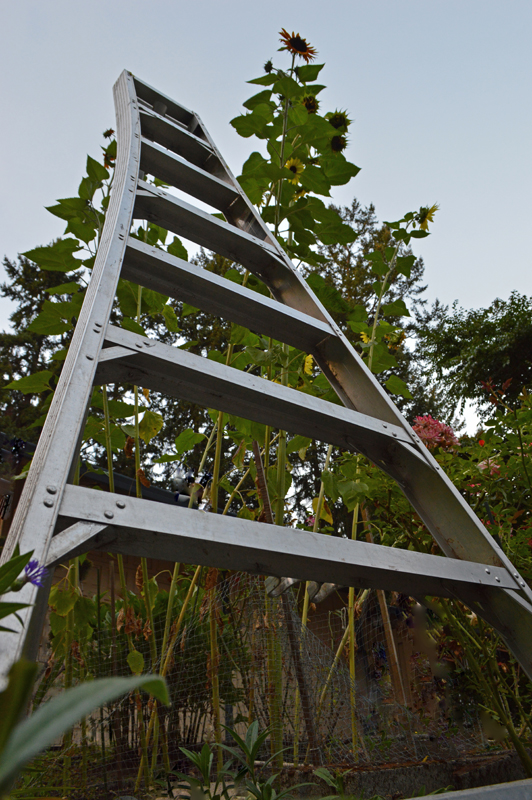
Photographing at Dusk with a flash and close-up focus prevented the sunflower centers from appearing as a flat black disk, especially for photographs later converted to black and white.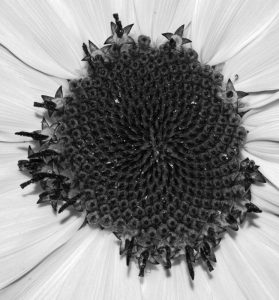
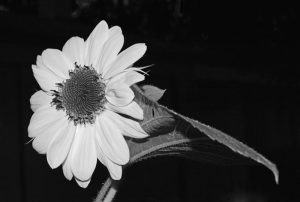
That combination of lighting also tuned out the cars, mailboxes and houses nearby.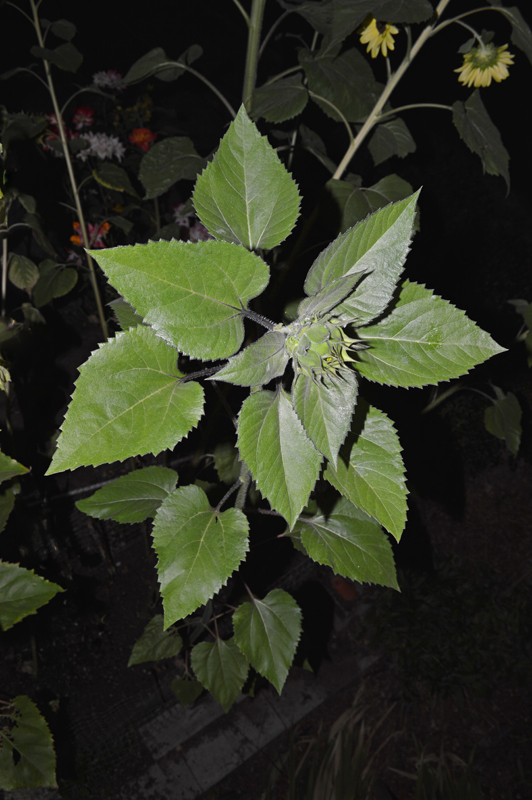
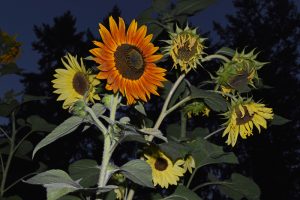
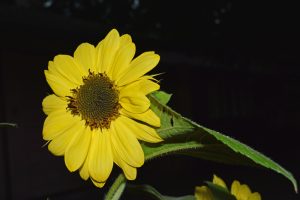
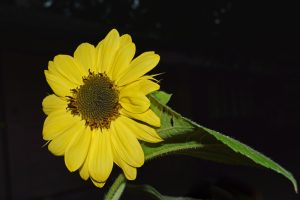
The seed packet promised beautiful-bountiful-bunching-blooms (try saying that 10 times fast!), which have been a delightful subject to photograph.
They also provided the challenge of learning how to aim around and Photoshop out extra blooms for the parts of the Yellow, Red, Orange Tale that focused on a single character/flower.
We’re sure that sunflower seeds must be brain-food, since the flowers have exercised our brains so much!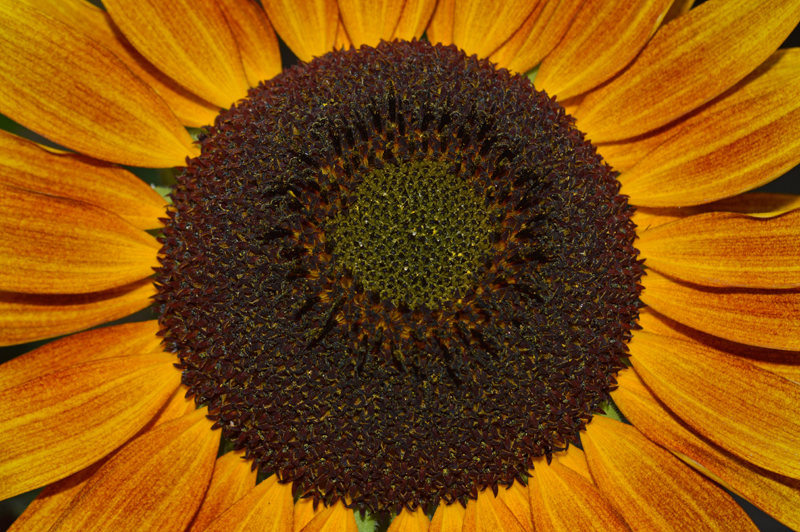
 “Photoshop vs. Nature: Smack-down in the Garden!” . . . catchy right? This was our Tale’s first title.
“Photoshop vs. Nature: Smack-down in the Garden!” . . . catchy right? This was our Tale’s first title.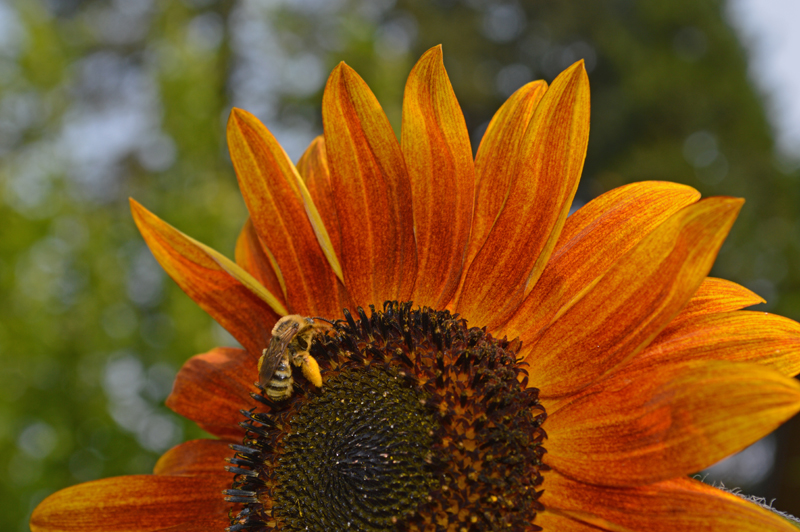
We wanted an interesting presentation to show a sampling of post-photography color changes.
A. As the camera saw it B. Brush, color replace
B. Brush, color replace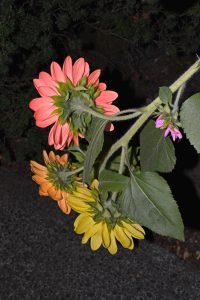 C. Adjust hue/saturation
C. Adjust hue/saturation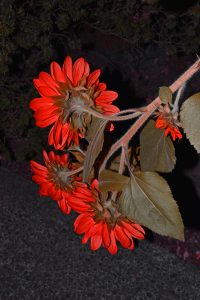 D. Paintbucket
D. Paintbucket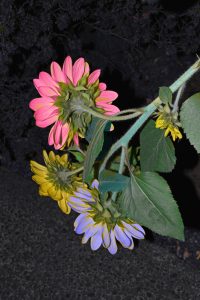
However, as these wonderful sunflowers grew, this working title didn’t really match the garden’s mood.
When our Garden-Enthusiast Neighbor and her husband put up this netting to protect the sunflower bed from local wildlife, the young plants looked like toddlers peeking their noses over a playpen as they grew.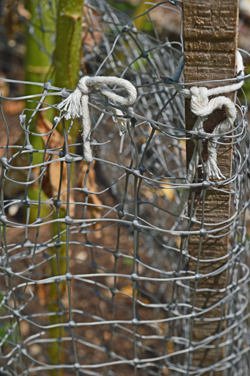
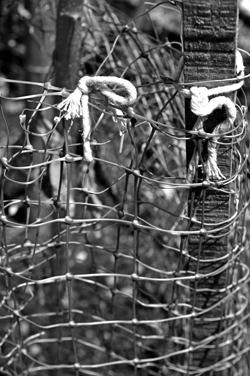
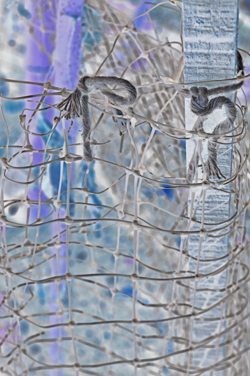
Then, as the flowers inspired photographs like these . . .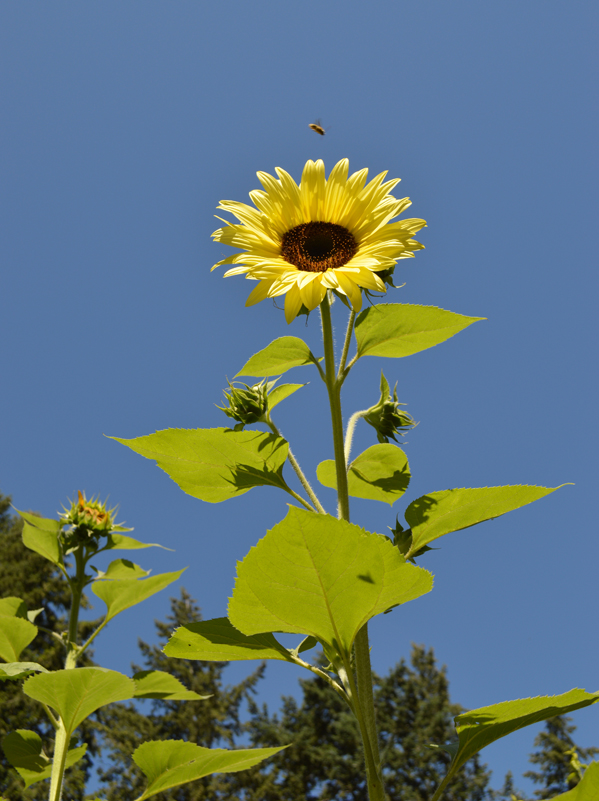
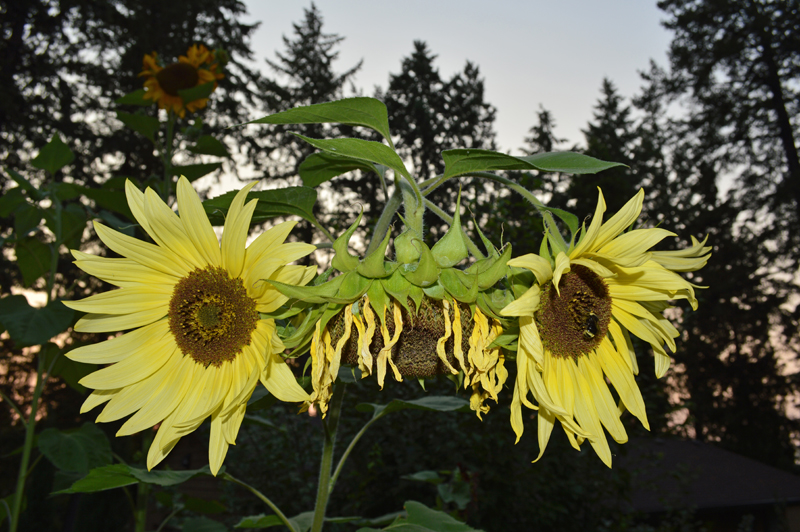
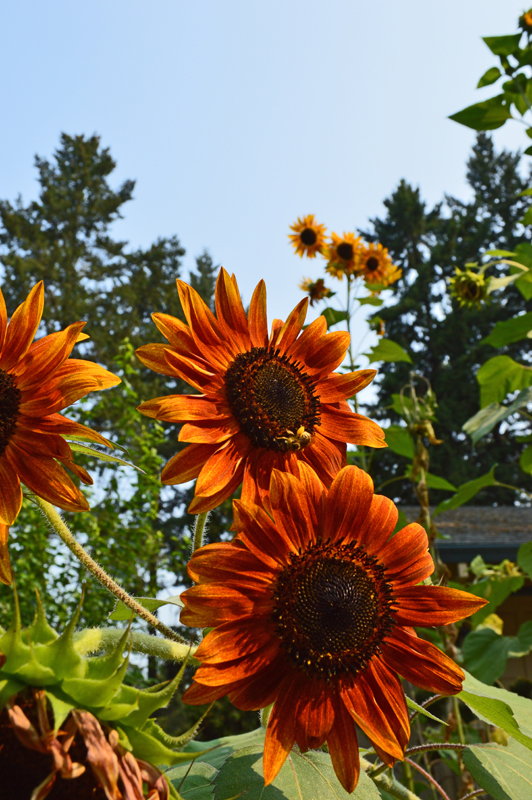

. . . the gist of the tale gradually became a moment of inner conflict on the path to maturity for the young “teen”flowers.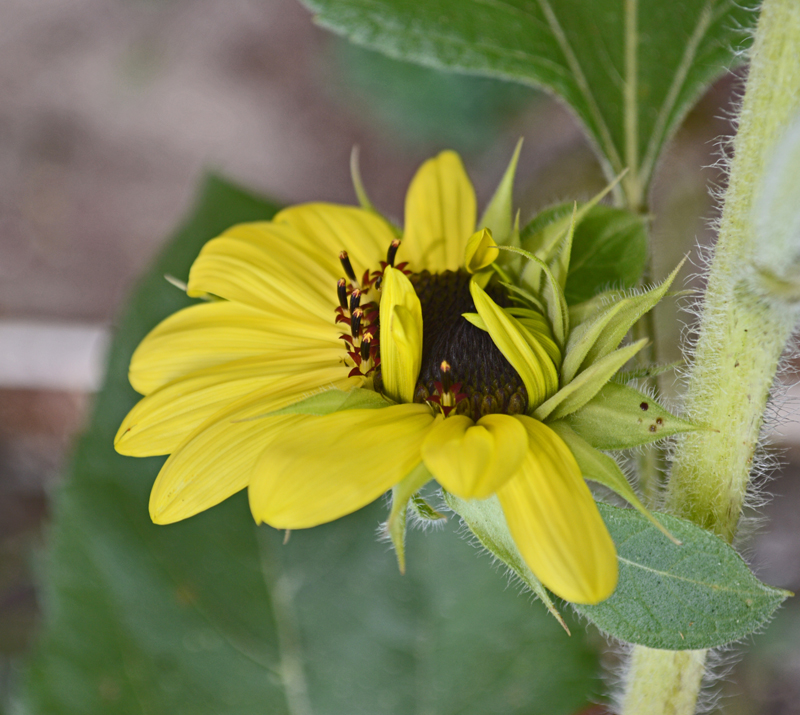
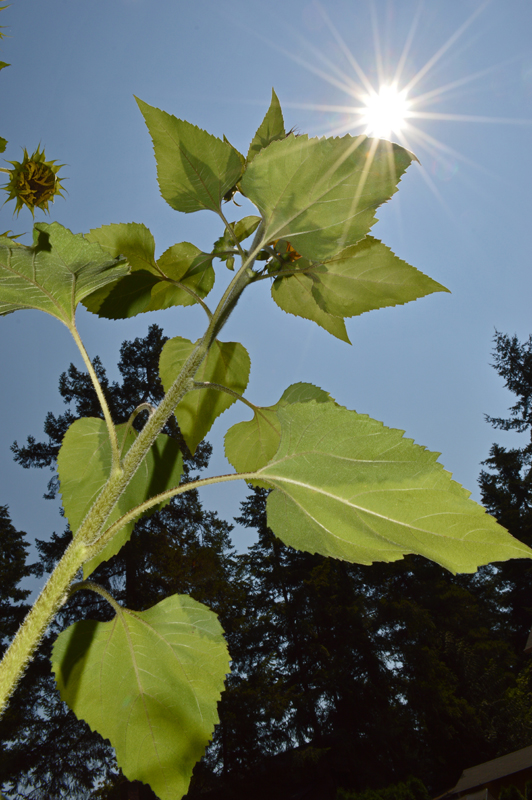
There is a certain irony with the plot of the tale, since photographing the flowers was actually the most peaceful time of the workday!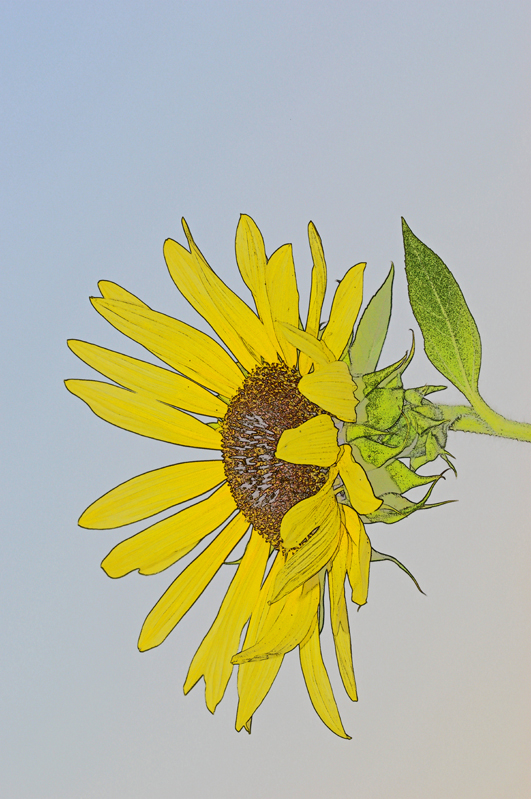
Once upon a time there was a Yellow Sunflower.
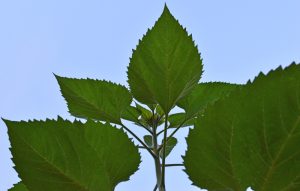 Yellow Sunflower had grown with the loving care of its Gardener who protected it from every danger as seed and seedling, marveled at its hourly growth . . .
Yellow Sunflower had grown with the loving care of its Gardener who protected it from every danger as seed and seedling, marveled at its hourly growth . . .
thrilled at the new bud opening. . . 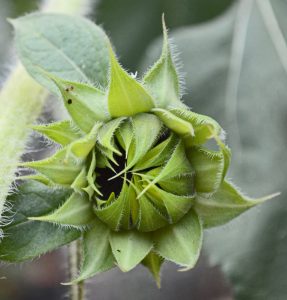
and eagerly watched each petal unfold . . .
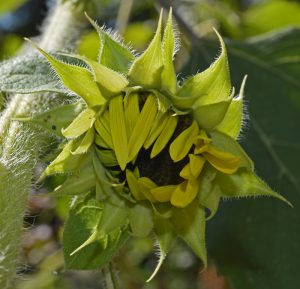
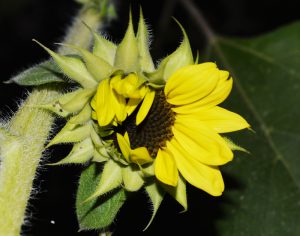
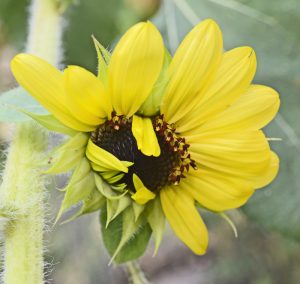
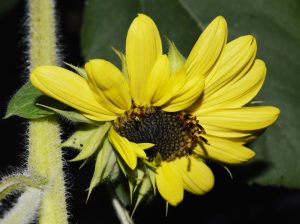
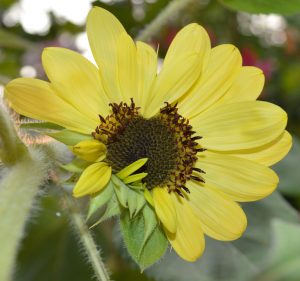
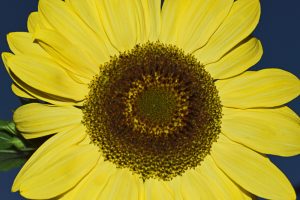 Yellow Sunflower was so occupied with BASKING IN THE SUNLIGHT, DELIGHTING THE BEES, AND GROWING SEEDS FOR THE BIRDS, that it was oblivious to the special care it received from the Gardener.
Yellow Sunflower was so occupied with BASKING IN THE SUNLIGHT, DELIGHTING THE BEES, AND GROWING SEEDS FOR THE BIRDS, that it was oblivious to the special care it received from the Gardener.
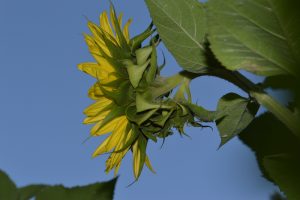 What did catch Yellow’s attention was one day overhearing the Gardener’s excitement that there was a Red Sunflower about to open!
What did catch Yellow’s attention was one day overhearing the Gardener’s excitement that there was a Red Sunflower about to open!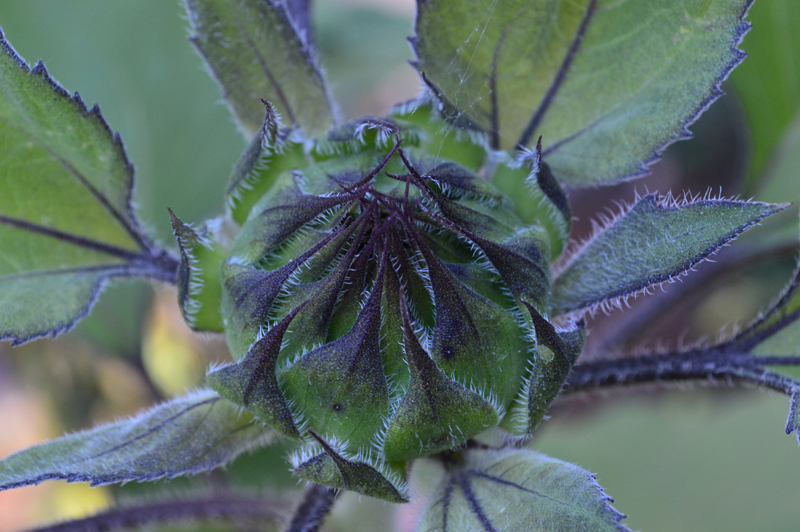
“Hey!”, thought Yellow, “Red Sunflower gets ALL the attention!”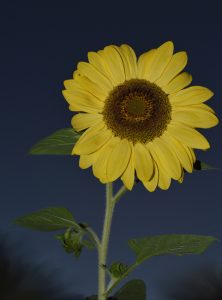
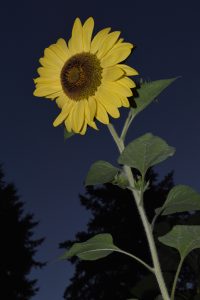 The gloominess grew in the garden.
The gloominess grew in the garden. 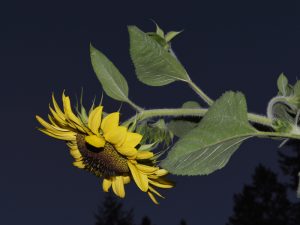
“Red Sunflower must be very special to get all that attention”, glowered Yellow, “all I get to do is get a tan, hang with the bees and go to seed.”
Continuing in the same vein, led to this light green tint of envy: “Red flowers probably get to roller skate,
eat ice cream
and watch TV!”
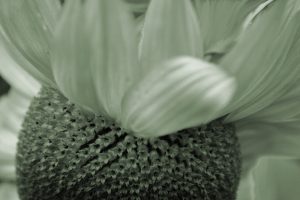
“I want special attention like Red Sunflower!”
Yellow was puzzled about what to do: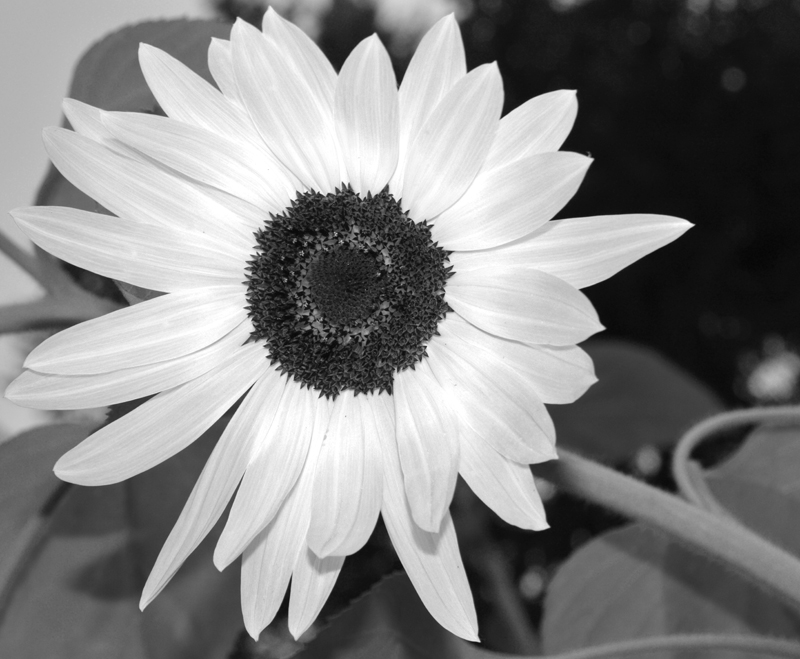 “You might even say, ‘I’m hueless about how to change color!”
“You might even say, ‘I’m hueless about how to change color!”
Yellow had an idea: “wait a minute! I’ve READ the most recent posts, I know what to do! ” (Yellow Sunflower, being an only recently opened blossom, had never heard of homonyms.) So, Yellow sampled various ways to change color.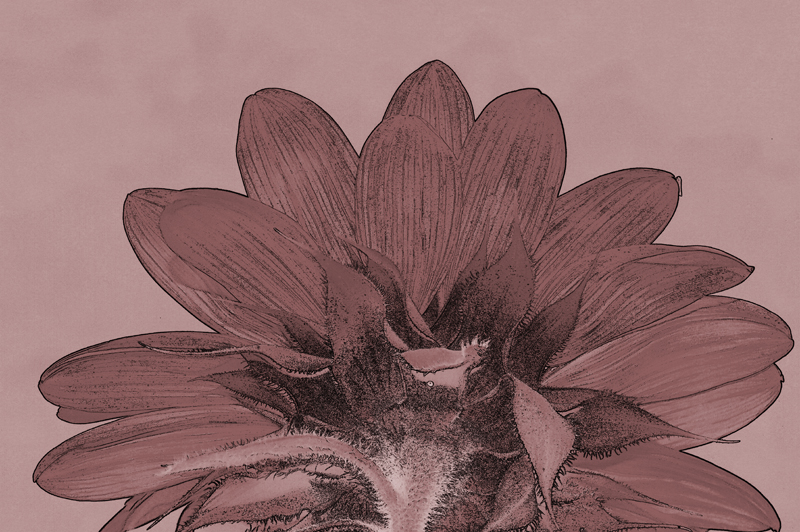
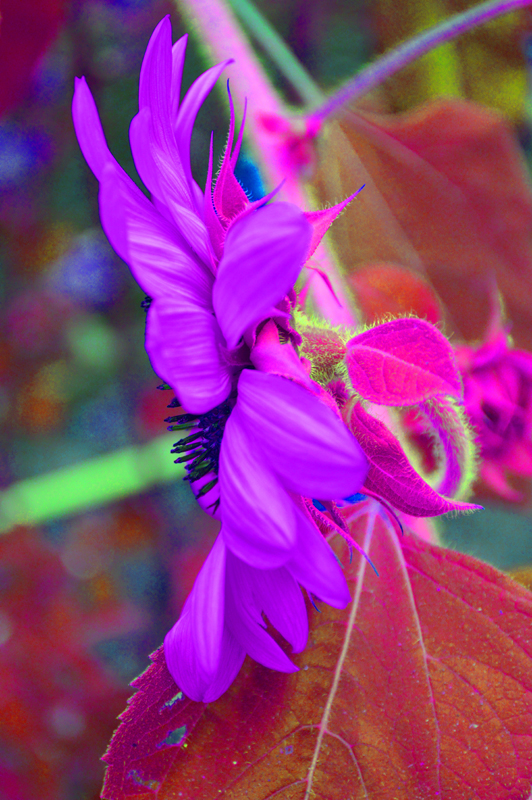
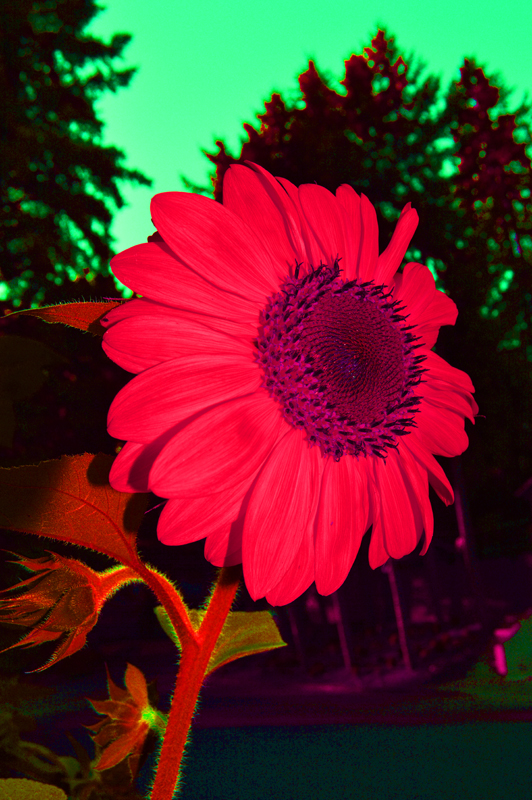
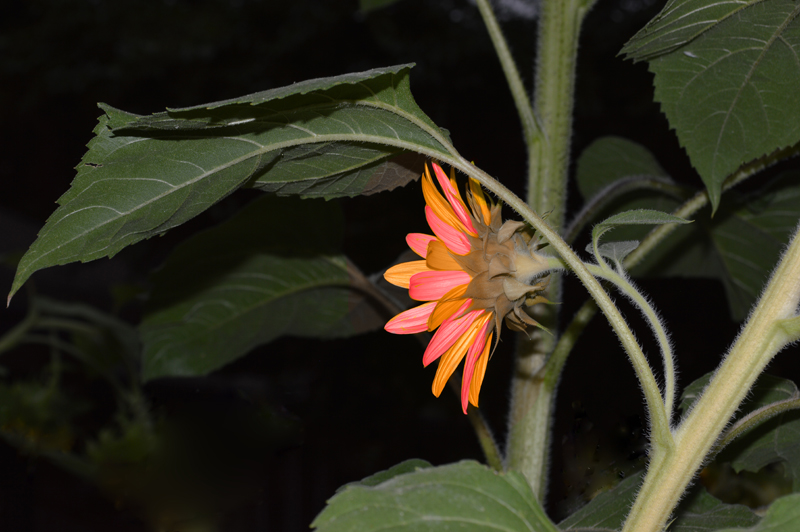
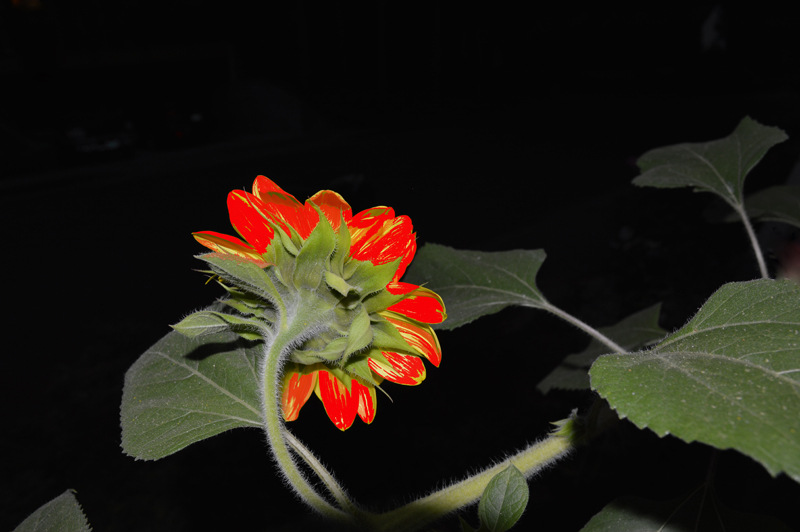
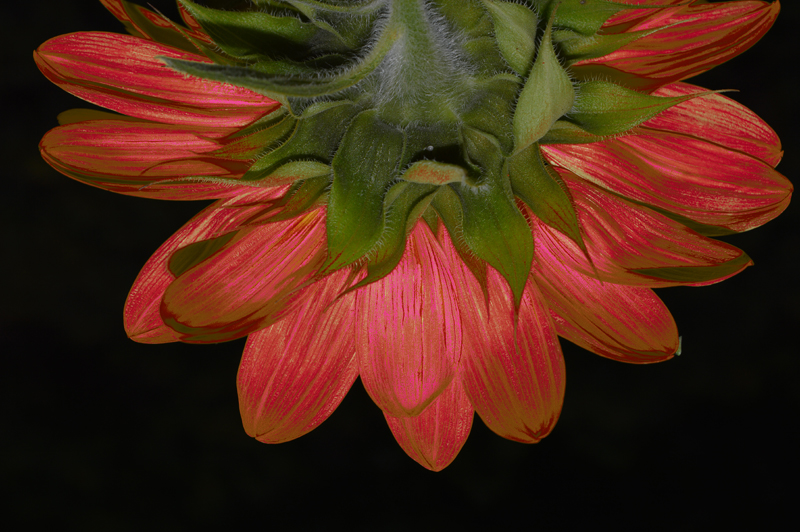
Whew! Yellow Sunflower was beginning to lose its sense of Self, as though being erased away:
Then, one day Yellow looked around and saw: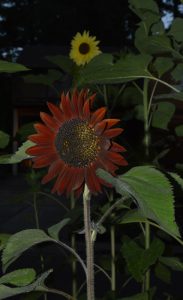
Real Red Sunflower was beautiful! But more importantly, Red Sunflower BASKS IN THE SUN, FEEDS THE BEES AND GROWS EQUALLY NUTRITIOUS SEEDS!
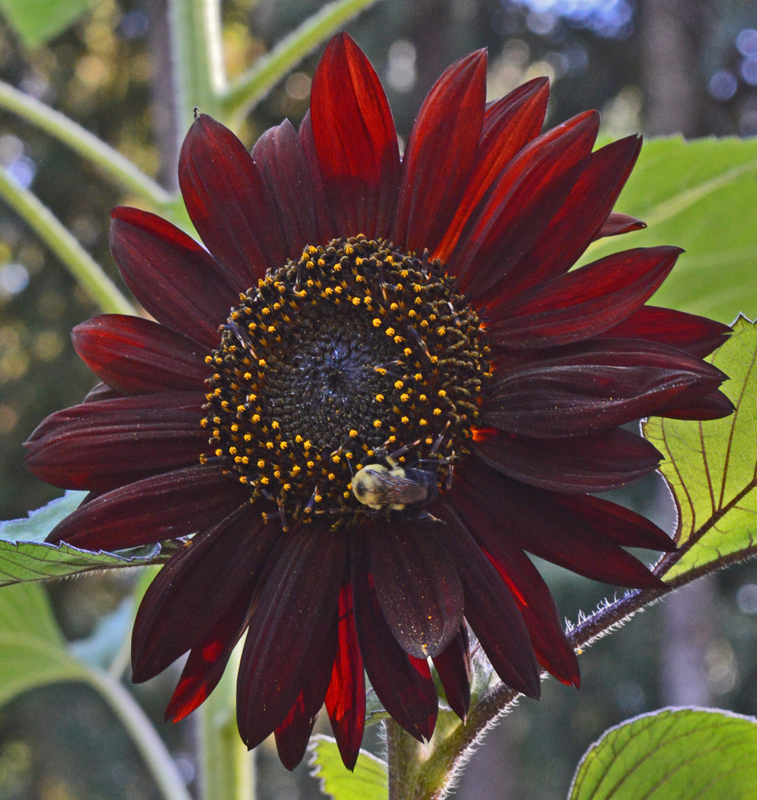
 Dawning of realization can occur after sunset for Sunflowers. For the benefit of those Dear Readers confined to a tiny screen:
Dawning of realization can occur after sunset for Sunflowers. For the benefit of those Dear Readers confined to a tiny screen: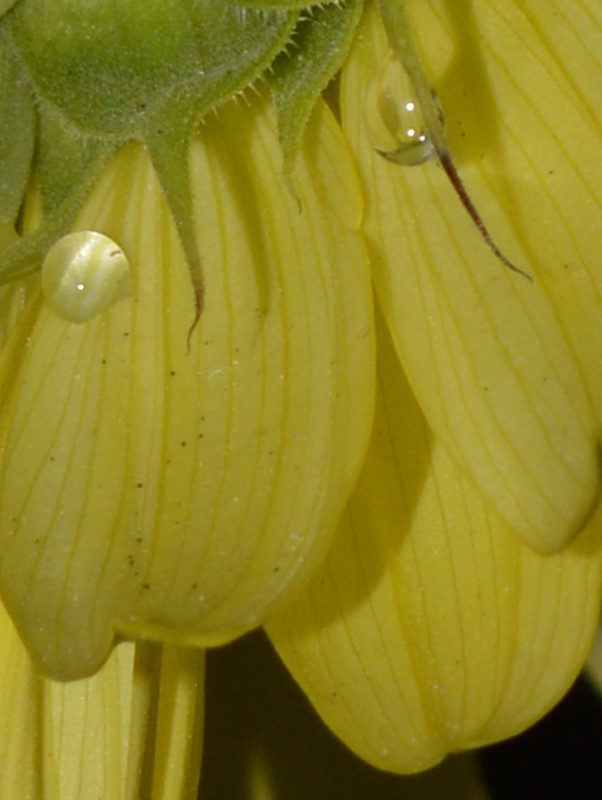 And then, Yellow Sunflower realized the beauty in the garden was that ALL the sunflowers equally GLORIED IN THE SUN, NOURISHED THE BEES and GREW SEEDS TO SHARE IN THE FUTURE! Sharing one’s gifts is wonderful of course, but recognizing them in one another is what makes them feel like a gift! When Yellow appreciated Red’s gifts, Yellow felt special too!
And then, Yellow Sunflower realized the beauty in the garden was that ALL the sunflowers equally GLORIED IN THE SUN, NOURISHED THE BEES and GREW SEEDS TO SHARE IN THE FUTURE! Sharing one’s gifts is wonderful of course, but recognizing them in one another is what makes them feel like a gift! When Yellow appreciated Red’s gifts, Yellow felt special too!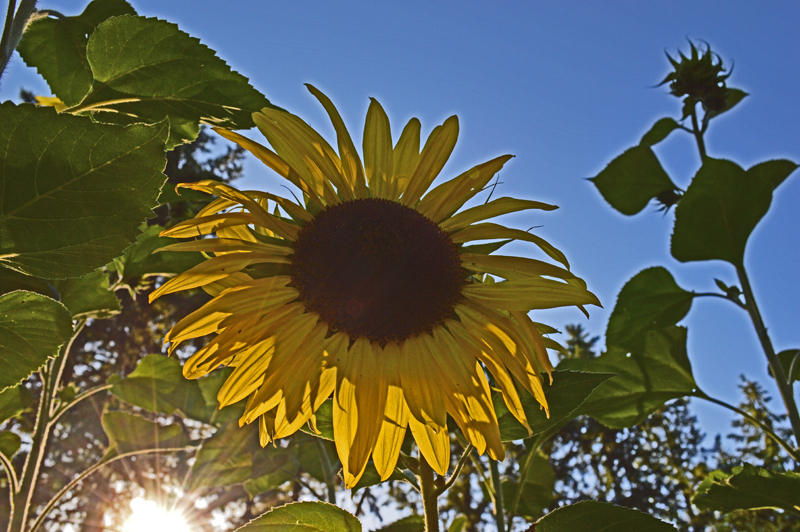
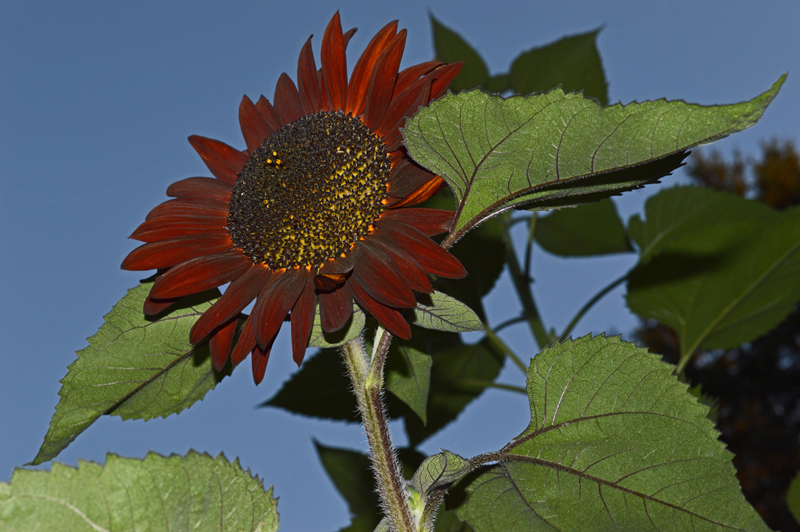
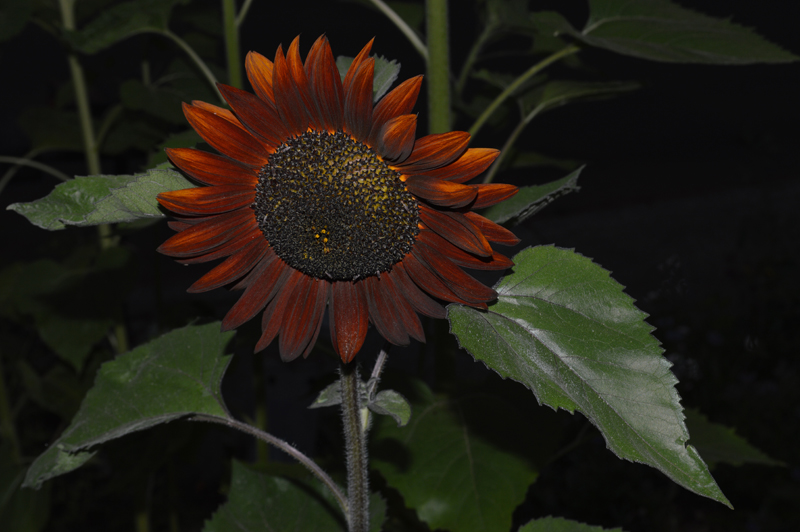
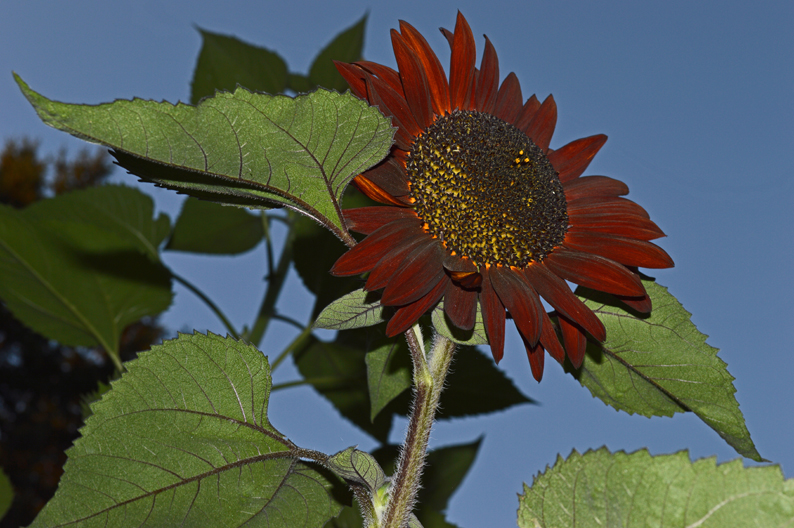 Red Sunflower was so occupied doing its own thing that it was completely oblivious to all this drama!
Red Sunflower was so occupied doing its own thing that it was completely oblivious to all this drama!
This is a true tale as recounted to us by Orange Sunflower, who was witness to the whole spectacle!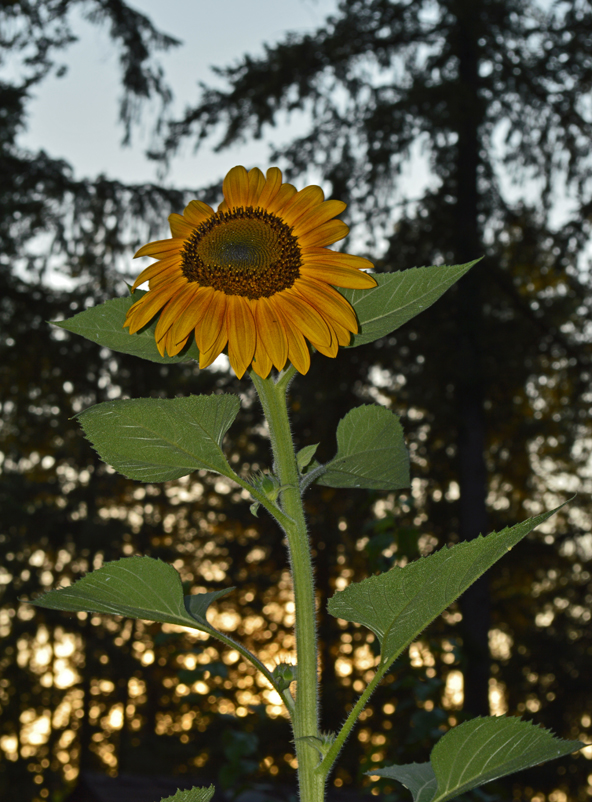
 “White Hydrangea Sepals – Light Study”
“White Hydrangea Sepals – Light Study”
Warmish/Coolish, Part I examples
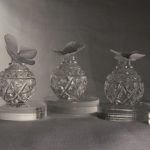
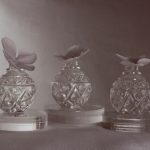
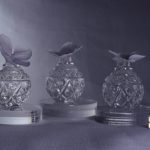

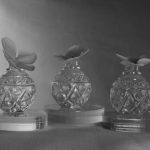

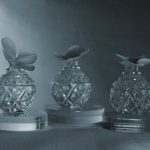
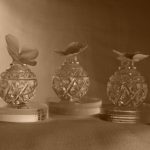
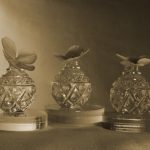
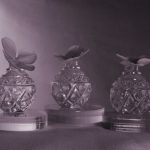
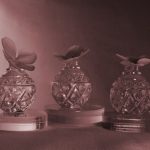
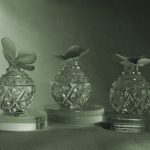
Warmish/Coolish Parts I & II took hours to prepare. What a lot of work for curiousity’s sake! Of course, it is practical to increase one’s knowledge base when learning new techniques.
Consider this though, making choices is the fun part of Creativity, selecting among the choices is the skill-building part of Artistry, learning from that discernment is the growth part of Professionalism.
You’ve probably already discovered for yourself that trying new things can help when stalled out in the studio. This approach also works when your destination ahead is too certain. Spend some time creating options for the sake of choosing.* You may still stay with the original idea, but you have come from a different direction to get there and along the way enriched your perspective. Notice the enlargement used to lead into this post is the original photograph!
*P.S. Disregard this advice if you have a pressing DEADLINE!!!!!!! And we wish you lots of luck on it!